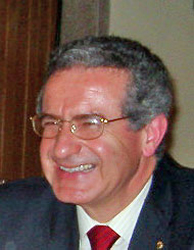 Orlando
Alves Da Silva
Orlando
Alves Da Silva
Oftalmolog, seful departamentului Strabism al spitalului Santa Maria din Lisabona.
Director al clinicii Posturmed.
Fondator si presedinte al societatii portugheze de Posturologie si Dislexie.
Profesor de oculomotricitate la liceul de ortoptica din Lisabona.
Coautor al doua carti de posturologie si al mai multor articole si expozitii pe acest subiect.
Fondator si presedinte adjunct al grupului portughez de oftamologie si strabism pedriatic.
Orlando Alves da Silva lucreaza din 1977 cu H.Martins da Cunha care a descris pentru prima oara sindromul deficientei posturale(1979).L-a ajutat pe Cunha referitor la studierea acestui sindrom si este directorul scolii de posturologie din Lisabona.
Prismele Alves da Silva sunt folosite in multe in multe tari pentru tratamentului sindromului deficientei posturale, manifestari algice, dezechilibre si dislexie.
Postura si sistemul proprioceptiv lent
In 1979, Martins da Cunha H. described the Postural Deficiency Syndrome (PDS).
This syndrome is characterized by many clinical manifestations, reaching several segments of the human body and several body systems apparently not related.
Unbalance, muscular pain, headache, blood irrigation disturbances, asthenopia, wrong space perception and Dyslexia were some of the clinical manifestations never related to each other before.
In 1977, two years before the publishing of PDS, Martins da Cunha invited the author for studying the PDS`s visual manifestations in order to obtain an explanation for some clinical manifestations he had observed but couldn't understand. He wanted to know from an ophthalmologist why did his patients have a preferential looking position, why they wrongfully localized the figures in the Maddox Wing, why they couldn't see all the figures in the Maddox Wing and why they were able to do all this properly after performing postural reprogramming. Unfortunately, ophthalmology had no answer for him. However, the ophthalmologist he invited accepted this challenge and this paper is a consequence of it.
Many years of clinical and laboratorial research performed together and in association with some researchers gave the answer to Martins da Cunha. All these apparently not related clinical manifestations are, all together, a consequence of the slow proprioceptive system dysfunction. Proprioception is much more than just our sixth sense. In truth, it is the afferent neurological pathway of this system.
Clinical manifestations do not result directly from wrong posture. These only reveal themselves when wrong posture is able to induce a proprioceptive system dysfunction.
The author explains his concept of slow proprioceptive system based on a clinical experience of more than 30,000 cases of SDP patients he has observed until now.